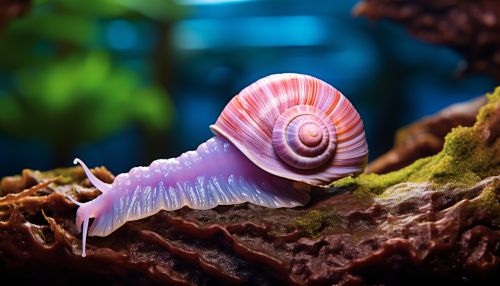Mollusks
Introduction
Mollusks, or molluscs (Mollusca), constitute one of the largest phyla in the animal kingdom, with over 85,000 recognized extant species. The number of fossil species is estimated to be between 60,000 and 100,000 additional species. These diverse organisms occupy marine, freshwater, and terrestrial environments, exhibiting a remarkable range of morphological diversity and ecological adaptations.


Anatomy and Morphology
Mollusks are characterized by a soft body that is often protected by a hard shell. The body plan of mollusks typically includes a head, a visceral mass, and a foot. The head usually bears sensory organs such as eyes and tentacles. The visceral mass contains most of the internal organs, while the foot is a muscular organ primarily used for locomotion.
Shell
The shell, when present, is a significant aspect of a mollusk's anatomy. It is typically composed of calcium carbonate and is secreted by a part of the molluscan body known as the mantle. The shell provides protection against predators and environmental conditions. However, not all mollusks possess shells; notable examples include the cephalopods, such as the squid and octopus.
Mantle and Mantle Cavity
The mantle is a significant organ in mollusks, responsible for the secretion of the shell and also forming a cavity used for respiration and excretion. The mantle cavity houses gills or lungs, depending on the mollusk's habitat.
Radula
A distinguishing feature of mollusks is the presence of a radula, a specialized feeding organ. The radula is typically composed of rows of microscopic chitinous teeth and is used by mollusks to scrape food particles off surfaces.
Classification and Diversity
Mollusks are incredibly diverse, both in terms of morphology and habitat. They are typically divided into seven classes: Aplacophora, Monoplacophora, Polyplacophora, Gastropoda, Bivalvia, Cephalopoda, and Scaphopoda.
Gastropoda
The Gastropods, also known as snails and slugs, are the most diverse class of mollusks, with over 60,000 species. They are characterized by a torsion, or twisting, of the body during development.
Bivalvia
The Bivalves, including clams, oysters, and mussels, are characterized by a shell divided into two hinged parts. They are primarily filter feeders and have a significant impact on their ecosystems through their feeding habits.
Cephalopoda
The Cephalopods, including squids, octopuses, and cuttlefish, are a group of mollusks known for their intelligence and complex behaviors. They are characterized by a well-developed head and a set of tentacles.
Ecology and Life History
Mollusks occupy a wide range of ecological niches, from the deep sea to high mountain regions. They play essential roles in their ecosystems, often serving as primary consumers that help to control algae and detritus levels.
Mollusks exhibit a wide range of reproductive strategies. Some species are dioecious, with separate male and female individuals, while others are hermaphroditic, possessing both male and female reproductive organs. Many marine mollusks have a planktonic larval stage known as a trophic veliger.
Human Interaction
Humans have interacted with mollusks for thousands of years, using them for food, tools, and ornamentation. Today, mollusks continue to be an essential resource for humans, particularly in the form of shellfish.
However, human activities have also had a significant impact on mollusk populations. Overfishing, habitat destruction, and climate change are all significant threats to many mollusk species.
